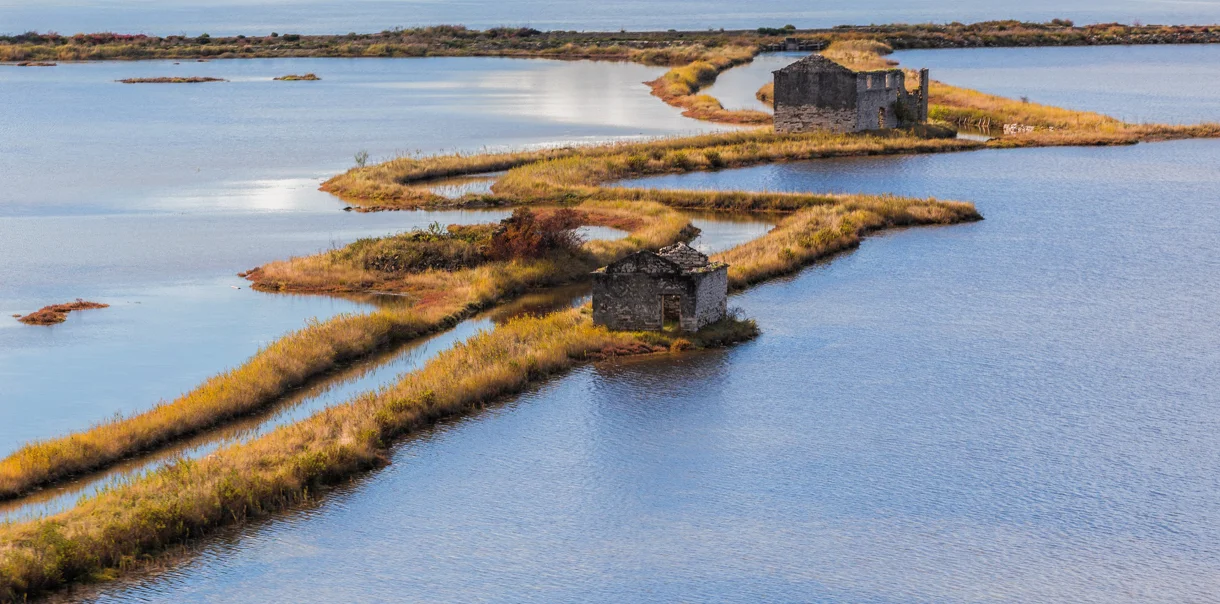Most visitors come to the saltpans and nature parks during the summer, but late autumn and winter are also great for a lovely trip. Especially for those who need a break from the monotonous and often foggy and cold autumn weather. Visiting the saltpans is more than just a day-trip to the seaside. In the saltpans of Sečovlje near the mouth of the river Dragonja and the saltpans of Strunjan one can wander amongst the numerous channels used for salt making. Winter is a quieter season and thus ideal for birdwatching and getting to know salt-loving plants, which are endemic to this type of environment.

Curiosities / Winter on the coast – saltpans
Winter also has its charm, even more so on the coast than in the mainland. During cold winter days the Slovenian coast is the only haven where you can stroll in the sunshine without getting chilled to the bone. During the day temperatures can reach 10 degrees Celsius, which is just the right temperature for a leisurely stroll along the sea. The idyllic ambiance is accompanied by the smell of salt, clear skies and the blue sea. Boats are rocking gently by the piers, seagulls flying in the sky, the promenades have lost the summer crowds and await invitingly.


Winter is ideal for visiting the saltpans!
It is also a very important season for salt harvesting. Salt workers, especially those who worked in the old saltpans, say that salt is made in winter. The quality of the salt harvested during the summer months depends on the conservation and maintenance of the salt pools. In the saltpans it is always necessary to work with the weather, as the quantity of the salt harvest depends on the knowledge of weather conditions, winds, tides, etc.
The saltpans keep winter lively!
The visitors of Sečovlje saltpans can choose among three Salt worker's paths. The first is in the part called Lera, where salt is still being produced. There are guided tours available. Qualified nature conservation officers take us through centuries of salt making in this area and acquaint us with the traditional methods of salt production and its unique aspects that can’t be found anywhere else in the world. The remaining two paths are in the southern part in the area called Fontanigge, where salt production ceased after the Second World War. Here we can visit the museum and have a closer look at the part of the saltpans dedicated to nature. There are numerous options for walks in Fontanigge... The saltpans also have a Museum of salt making, which is located near the Giassi channel in one of the reconstructed salt worker’s houses. It has an exhibition, a salt pool and its adjacent seawater conduit channel. The path to the Museum of salt making takes you from the entrance gate along the Dragonja river and is 2.5 km long (one way). The Museun of salt making can be visited by sea with the boat Solinarka, by bicycle, on foot and exceptionally also by bus.

The salpans of Strunjan – points of interest
The saltpans of Strunjan also have marked pathways for visitors. The circular educational path Strunjan and the sea is ideal for a stroll in late autumn or winter. The informative boards are a great guide for a curious and relaxed walk in nature. Those visitors who want to learn something new about the natural and cultural peculiarities of the Nature park Strunjan can choose among various educational paths in unspoiled nature: there’s a botanical path, a geological path, a geographical path and a subaqueous path. All paths can be visited with a guide, individually or in a group. The classic guided sightseeing tour of the saltpans, the lagoon and the cliffs with the sea takes at least 2 hours and is approximately 4 km long.

Visitors can also choose a shorter 1h guided tour of the cliffs or of the lagoon Stjuža with the saltpans, where they’ll learn more about the production of salt. The shorter tour covers a distance of approximately 1,5 km. The path along the lagoon takes us to the new Visitors centre, where we can see an exhibition and a film about the park, the formation of the saltpans, the traditional ways of salt making and the characteristic flora and fauna that adapted to the salty environment.
Saltpans in Slovenia
Wide and shallow water surfaces in the calm Mediterranean climate have always been full of life. Their inhabitants were not only salt workers, but also animals and plants that adapted to the salty environment. The most unique are the salt-loving plants or halophytes. Many of these turn red in autumn, after they have extracted all the nitrogen from the nutrients’ deprived soil.

The saltpans are an ideal habitat for birds. Many diverse biotopes have formed in the embankments, where birds rest overnight or during winter. 296 species have been seen so far. The channels and ponds are inhabited by the tooth carp and during summer we can find the tiny (no more than a centimetre large) red saltpan shrimp.
Salt making, a tradition lasting millennia
In this part of Slovenia salt making has been a tradition for thousands of years. The saltpans of Sečovlje and Strunjan have preserved the traditional ways of salt making. In the past there were numerous saltpans in the Gulf of Trieste, but presently only those in Sečovlje and Strunjan are still preserved, which makes their testimonial value even greater. Their importance in the aspect of ethnological, technical, historical, settlement and landscape heritage is exceptional. The saltpans of Strunjan and Sečovlje are the only saltpans along the eastern coast of the Adriatic Sea where salt is still produced with traditional methods throughout the entire process, by daily gathering it in brine on the biosediment - petola.

For centuries the saltpans of the Northern Adriatic Sea exerted a great impact on the economy of the states and city-states of this region. They were often the cause of political disputes and wars, as salt was incredibly useful, a valuable raw material and a strategic merchandise, important for the canning of food and the production of gunpowder. Besides Piran’s old saltpans in Sečovlje, Lucija and Strunjan, there used to be several smaller and larger saltpans in the Gulf of Trieste and in Istria (in Muggia, Koper and Izola). They were marked not only by political and economic interests, but also by the whimsicality of nature, which at times completely prevented salt making for longer periods of time, or endowed it with a super-abundant harvest at some other time. Today, the economic role of saltpans is secondary to their value in terms of nature conservation and cultural heritage:
|
|
|

Fleur de sel
The most precious product of the saltpans is fleur de sel. The tiny pyramidal crystals are formed only in the calmest weather conditions and their colour ranges from white to light pink. When the time of harvest comes, the saltpan workers use a special net in a wooden frame to carefully collect only the upper layer. The salt from Piran’s saltpans is very rich in minerals. Its distinctive taste and quality are highly renowned among culinary experts and have earned it a special place among the “fleur de sel” salt variety.
Useful links – sources – to help you plan your trip to the saltpans during winter:










